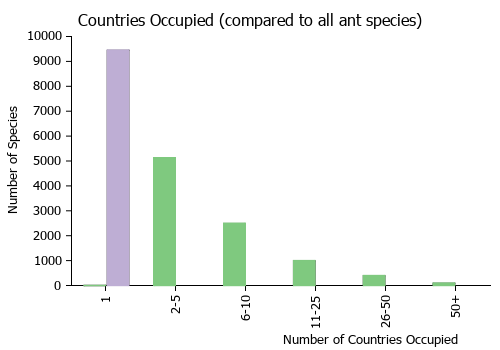Hylomyrma mariae
| Hylomyrma mariae | |
|---|---|
| Scientific classification | |
| Kingdom: | Animalia |
| Phylum: | Arthropoda |
| Class: | Insecta |
| Order: | Hymenoptera |
| Family: | Formicidae |
| Subfamily: | Myrmicinae |
| Tribe: | Pogonomyrmecini |
| Genus: | Hylomyrma |
| Species: | H. mariae |
| Binomial name | |
| Hylomyrma mariae Ulysséa, 2021 | |
This species is only known from its type locality, and inhabits areas at elevations between 1340 and 2200 m. Most specimens were collected from rotten wood, humus, and leaf-litter submitted to Berlese-Tüllgren funnels. (Ulyssea & Brandao, 2021)
Identification
Irregular and longitudinal striae on head dorsum diverge towards posterior margin; rugose striae on mesosoma and petiole; promesonotal junction and metanotal groove distinguishable by a slight depression (LV) and altered sculpture (DV); dorsal margin of petiole discontinuous; subtriangular projection on mesoventral surface of petiole; node ventral surface striate transversely; profemur posterior surface entirely striate; striae transverse and well-marked; protibia extensor surface entirely striate, striae weakly marked; long striae on first gastral tergite.
Hylomyrma mariae is similar to Hylomyrma adelae and Hylomyrma dandarae. Hylomyrma mariae differs from H. adelae (characteristics in parentheses) in the irregular divergent-longitudinal striae on the head dorsum (vs. rugose striae), the distinct metanotal groove (vs. indistinct), the longer propodeal spine (vs. shorter), the profemur posterior surface with striae weakly marked (vs. well-marked), and the dorsum of petiole with rugose striae (vs. irregular and transverse striae). The two species are allopatric; Hylomyrma mariae occurs in northern Colombia (Fig. 88), and H. adelae in Bolivia (Fig. 83). Hylomyrma mariae differs from H. dandarae in the drop-shaped eye (vs. oval), the shorter petiolar node (vs. longer), and the long striae on tergum of the first gastral segment that extends up to its first third (vs. short striae). The two species occur in Colombia (Figs. 83, 88).
Keys including this Species
Distribution
Latitudinal Distribution Pattern
Latitudinal Range: 11° to 6°.
| North Temperate |
North Subtropical |
Tropical | South Subtropical |
South Temperate |
- Source: Ulysséa & Brandao, 2021
Distribution based on Regional Taxon Lists
Neotropical Region: Colombia (type locality).
Distribution based on AntMaps
Distribution based on AntWeb specimens
Check data from AntWeb
Countries Occupied
| Number of countries occupied by this species based on AntWiki Regional Taxon Lists. In general, fewer countries occupied indicates a narrower range, while more countries indicates a more widespread species. |

|
Biology
Castes
Nomenclature
The following information is derived from Barry Bolton's Online Catalogue of the Ants of the World.
- mariae. Hylomyrma mariae Ulysséa, in Ulysséa & Brandão, 2021: 75, figs. 50, 88 (w.q.) COLOMBIA.
- Type-material: holotype worker, 10 paratype workers, 1 paratype queen.
- Type-locality: holotype Colombia: Cincinnati, ii.1924 (W.M. Mann); paratypes: 9 worker with same data, 1 worker Colombia: San Pedro de la Sierra-Pico Yerbabuena, 2200 m., 18.ii.1977, vial 13 (C. Kugler), 1 queen with same data as last but 1730 m..
- Type-depositories: USNM (holotype); CASC, DZUP, IAVH, MCZC, MZSP, USNM (paratypes).
- Distribution: Colombia.
Type Material
- Holotype: COLOMBIA: [Magdalena]: Cincinnati, Feby 1924, W.M. Mann (1W) [USNM].
- Paratypes: same data as holotype (3W) [CASC, DZUP, IHVL]; (2W, one covered with gold) (MZSP67393, MZHY205) [MZSP]; (4W) [USNM]; San Pedro de La Sierra—Pico Yerbabuena, C. Kugler col., 2200m, berlesate rot. wood & humus, 18.feb.77, vial 13 (1W) [MCZC]; same except 1730m, berlesate humus & lf. Litter, 18.feb.77 (1Q) [MCZC].